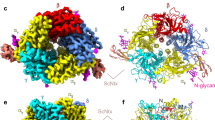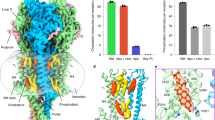Abstract
BOTH botulinum toxin1,2 and β-bungarotoxin3,4, isolated from the venom of Bungarus multicinctus, have been shown to block neuromuscular (NM) transmission by inhibition of the release mechanisms of the neurotransmitter. The inhibitory effect by either toxin is observed in the rat diaphragm only after a latent period, while the binding of both to the tissue seems to, be almost complete during the latent period3–5. There seem to be two processes for the inhibitory effect, the binding of toxins to the tissue, and the subsequent changes leading to the irreversible inhibition of the release mechanism of neurotransmitter4. The time course of the paralysis is markedly accelerated by an increase of stimulus frequency and delayed by procedures or factors which depress the activity of release mechanism, such as deficiency of calcium, increase of magnesium or decreased rate of nerve stimulation4–6. By contrast with botulinum toxin (ref. 2 and our unpublished data), β-bungarotoxin shows an initial facilitatory effect4, causing increases of the frequency of the spontaneous miniature end-plate potential and the quantal content of end-plate potential. Questions then arise as to whether or not they bind at a same site and act by a similar mechanism. We therefore studied the interaction between the two toxins in order to investigate the mechanism of the neurotransmitter release inhibition.
This is a preview of subscription content, access via your institution
Access options
Subscribe to this journal
Receive 51 print issues and online access
$199.00 per year
only $3.90 per issue
Buy this article
- Purchase on Springer Link
- Instant access to full article PDF
Prices may be subject to local taxes which are calculated during checkout
Similar content being viewed by others
References
Burgen, A. S. V., Dickens, F., and Zatman, L. J., J. Physiol., 109, 10 (1949).
Brooks, V. B., J. Physiol., 134, 264 (1956).
Chang, C. C., and Lee, C. Y., Arch. Int. Pharmacodyn., 144, 241 (1963).
Chang, C. C., Chen, T. F., and Lee, C. Y., J. Pharmac. Exp. Ther., 184 (in the press).
Simpson, L. L., Neuropharmacology, 10, 673 (1972).
Hughes, R., and Whaler, B. C., J. Physiol., 160, 221 (1962).
Lee, C. Y., Chang, S. L., Kau, S. T., and Luh, S. H., J. Chromatog., 72, 71 (1972).
Author information
Authors and Affiliations
Rights and permissions
About this article
Cite this article
CHANG, C., HUANG, M. & LEE, C. Mutual Antagonism between Botulinum Toxin and β-Bungarotoxin. Nature 243, 166–167 (1973). https://doi.org/10.1038/243166a0
Received:
Revised:
Issue Date:
DOI: https://doi.org/10.1038/243166a0
This article is cited by
-
Comparison of the presynaptic actions of botulinum toxin and ?-bungarotoxin on neuromuscular transmission
Naunyn-Schmiedeberg's Archives of Pharmacology (1974)
Comments
By submitting a comment you agree to abide by our Terms and Community Guidelines. If you find something abusive or that does not comply with our terms or guidelines please flag it as inappropriate.



